Imperial City, the historical heart of Hue in Vietnam, is a captivating destination that transports visitors back in time to the glory days of the Nguyen Dynasty. Steeped in rich history and cultural significance, this ancient imperial citadel offers a mesmerizing blend of architectural marvels, beautiful gardens, and fascinating stories waiting to be discovered. In this article, we will delve into our first-hand experience of taking an Imperial City walking tour in Hue, exploring its highlights, uncovering hidden gems, and sharing our overall impressions. Join us on this journey as we review the enchanting Imperial City walking tour and reveal why it is an absolute must for any traveller with an appreciation for history and culture.
Are you planning to visit Hue in Vietnam? Great choice there is so much to see and do in Hue you won’t be disappointed.
1.5 months into our 3 months travel in Vietnam, we travelled to Hue City which is located halfway between Hanoi and Ho Chi Minh City.
A lot of travellers bypass Hue (pronounced “hway”) but we are so glad that we didn’t. Hue has turned out to be one of our favourite and most beautiful places in Vietnam. Hue means ‘harmony’ and out of all the cities that we have visited, we totally agree with its name. The traffic is less crazy and frenetic than it is in the cities of Hanoi, Danang City and Ho Chi Minh and it seems to run at a slower pace as well. Maybe it is the Perfume River that slows the pace down.
During our time travelling Vietnam, we have avidly been learning about Vietnam’s history, joining historical and military walking tours and visiting museums trying to understand Vietnam’s involvement in many of her wars over the centuries. It seems that Hue over the years wore the brunt of many of the wars in Vietnam. Hue was located 8 miles south of the DMZ Zone and during the 1968 Tet Offensive experienced the heaviest of fighting between North and South Vietnam.
Do you need an e-sim card for Vietnam?
We have also learnt that if you are thinking of taking a tour that a guided tour is the way to go. Over the years we have spent too many hours just wandering aimlessly around a museum or a famous site not really understanding what we were looking at.
To understand Hue’s history our first step was to source an Imperial City Walking Tour. One of the top things to do in Hue is to visit the Imperial City.
We have negotiated a 5% discount for our readers by going direct to Bee Bee Travel and quoting promo code: totraveltoo2023
Promo Code: totraveltoo2023 to book your tour and get 5% offBook an Imperial Walking Tour here
Planning a trip to Vietnam read our ultimate travel guide here
You Can Read Our article on Vietnam: Best Vietnamese Restaurant Guide
FROM 1 JAN 2024
THE HUE IMPERIAL CITY ENTRANCE FEE IS 200,000 VND (USD9) PER PERSON and 20,000 VND (USD1.70) children
Join our Facebook Group – Vietnam Travel Planning. Our group has been created to assist you in your travel planning to visit Vietnam. Our community welcomes all your questions to help you. Join our group to get 5% discount off tours in Hue.
This post may contain affiliate links. Please see our disclosure for more information. As an Amazon Associate, we earn from qualifying purchases (if applicable).
Our Imperial City Hue Walking Tour Experience
Our YouTube Video takes you through the highlights of the Imperial City and the Museum of Antiquities.
We were staying in a central location in Hue at the Hue Garden Villa Hotel.
Our guide, My, from Bee Bee Travel met us at our hotel and we caught a taxi to a meeting point just outside the Imperial Citadel Hue where a family of 4 joined our group.
What is a Citadel?
Wikipedia states that a citadel “is the core fortified area of a town or city. It may be a castle, fortress, or fortified centre. The term is a diminutive of “city” and thus means “little city”, so-called because it is a smaller part of the city of which it is the defensive core.
The Hue Citadel is a square fortress with walls that are 6m high and 2.5 km long. The Imperial City is enclosed within the walls of the Hue Citadel.
UNESCO World Heritage Site
The Hue Imperial City was declared a UNESCO World Heritage Site in 1993.
Imperial City Hue Map
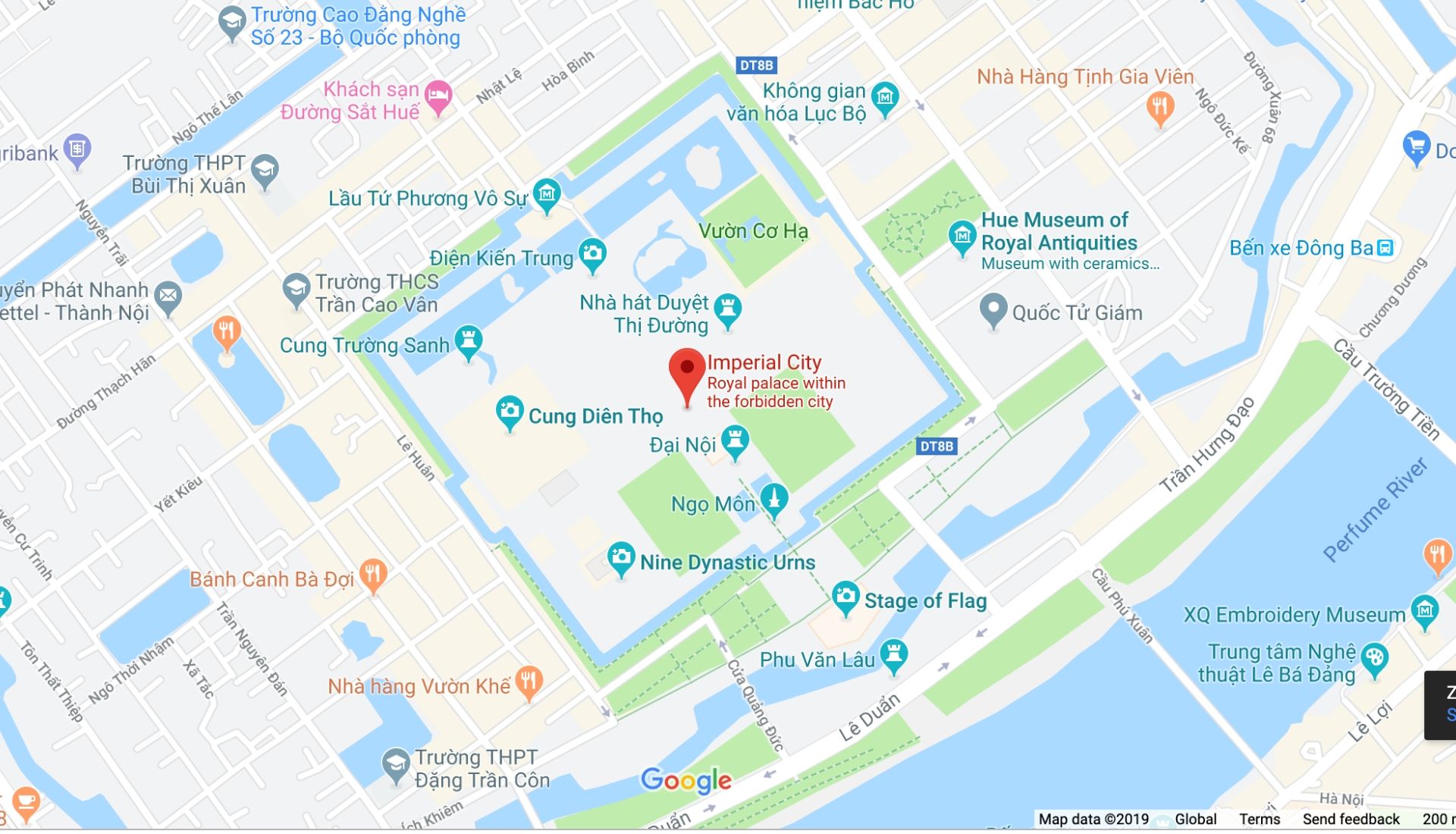
The Nine Holy Cannons

We started our Imperial City Hue Walking Tour just before 8.30 and headed to our first stop the Nine Holy Cannons.
Emperor Gia Long (more about him shortly) had the cannons cast in Hue between February 1803 and January 1804.
There are 4 seasons in a year (Spring, Summer, Autumn and Winter) and there are 5 natural elements (Fire, Metal, Wood, Water and Earth). Each cannon was given the name of the season or the element. The name of the cannon can be found etched at the tail.
The cannon specifications:
- length is 5.10m
- diameter is 0.23m
- weight is 11,000 kg
- there are motifs of flowers and leaves
- the cannons are engraved with the names of the person who controlled them
- the group of 4 seasons were placed on the left and the cannon group of 5 elements were placed on the right
- they are the biggest cannons in the country
- they have never been fired but used only for decorative purposes
The Flag Tower

As we left the Nine Holy Cannons our guide, My, led us towards the entrance to the Imperial City but not before we stopped to learn about the Flag Tower that dominated the skyline to our left. The Flag Tower is also known as the King’s Knight is located opposite the Noon Gate of the Imperial City. It was built during the reign of Emperor Gia Long in 1807.
The Flag Tower specifications:
- there are 3 terraces
- it stands at 17.40m high
- the first terrace stands at 5.60m high
- the second terrace stands at 5.8m high
- the third terrace stands at 6m high
- on top of the third terrace, there are 8 smaller buildings housing a cannon in each and 2 sentry boxes at either end
The Flag Staff stands at 29.52m high. It was originally constructed in wood but has been replaced 3 times and the last in 1948 where it was constructed out of concrete.
It was here at the base of the Flag Tower that the last Emperor of the Nguyen Dynasty – Emperor Bao Dai abdicated the throne in August 1945 ending the rule of the last Imperial Dynasty of Hue.
The Construction of the Hue Citadel and the Imperial City
Our guide, My, explained about the history of the Citadel and the start of the Nguyen Dynasty. The Nguyen Dynasty was founded in 1802 by Emperor Gia Long. Unfortunately, the Dynasty ended with the last Emperor Bao Dai in 1945. During this period Hue was the political, religious and cultural centre.
It was the first Emperor Gia Long that commissioned the Imperial City to be constructed. It commenced in 1805 and was completed in 1832 during the reign of Emperor Minh Mang, the 2nd Emperor.
Feng Shui Masters or Geomancers were consulted in the construction of the Imperial City. In Feng Shui, Geomancers will study the landform and consult accordingly. In the case of the Imperial City, the site was chosen because of the dominance of mountains in the North West to protect the rear of the city, support either side with the Green Dragon to the left and the White Tiger on the right by the two sand dunes. The location of the Perfume River at the facing of the Citadel is important in Feng Shui matters, as chi or energy stops at the boundaries of water, and further beyond is the Ngu Binh Mountains that acts as a protection to contain the energy or chi of the land.
On first glance at the Citadel, you would think that you were visiting the Forbidden Palace in Beijing. Interestingly the Forbidden Palace in Beijing was built facing South and the Imperial City of Hue was built facing South-East both built on Feng Shui principles.
The Imperial City is ringed by a 10 km moat. The water comes from the Perfume River by a series of sluice gates.
Imperial City Hue Opening Hours
The Citadel opening hours are from 07.00 to 17.30 hours.
The Main Entrance – The Noon Gate

As you stand at the entrance and view the Noon Gate, the grandeur and the size of the Citadel starts to dawn on you. You also start to wonder what is actually behind those gates and what is left after the bombings that occurred in January 1968, during the Vietnam War in the Battle of Hue. (We have jumped a few hundred years here to the Tet Offensive).
The Noon Gate, with its yellow lacquered doors, was for the exclusive use of the Emperor. To the left and right of the Noon Gate are the gates that were used by the civil and military mandarins. Either side of these two gates in an alcove are two more gates that were built high enough to allow elephants, horses and soldiers to enter.
As foreigners entering the Imperial City we were allowed to enter by the left-hand side gate. You can see the bullet holes from the battle on the walls as you enter.
Hall of Supreme Harmony (Thai Hoa Palace)

N.B. You are not allowed to take photos of the interior of the Hall of Supreme Harmony
The Hall of Supreme Harmony was constructed in 1805 by Emperor Gia Long. In 1806 his coronation took place here.
The Hall of Supreme Harmony was used for special events such as coronations, court events and receiving important ambassadors from other countries.
Outside in the square in front of the Hall of Supreme Harmony, you can see 2 rows of small steles. Here the Mandarins would stand, the most important at the first stele, waiting in line for an audience with the Emperor.
The Golden Throne takes pride of place inside the Hall of Supreme Harmony. It was here that the Emperor presided over the events of the day.
The Hall of Supreme Harmony contains 80 red lacquered columns. each column has the figure of the golden dragon engraved on it. Local artisans carved 9 dragons for the roof of the building.
During the Tet Offensive in 1968, the Thai Hoa Palace was severely damaged.
Purple Forbidden City

Behind the Hall of Supreme Harmony is the Purple Forbidden City. Construction started in 1804 during the reign of Emperor Gia Long and was completed during the reign of Emperor Khai Dinh. The Purple Forbidden City was for the Emperor, his family, servants and concubines. The Emperor was the only male allowed to enter the Purple Forbidden City.
It is believed that the Purple Forbidden City had up to 60 buildings contained within its walls.
Unfortunately, during the 1968 Tet Offensive most of the Forbidden City was destroyed, only the foundations remain of some of the buildings.
Royal Library

The Royal Library was constructed during the reign of Emperor Minh Mang. He used it as a private reading room. It was the only building that remained intact since 1947 when France reoccupied Hue.
To Mieu Temple Complex
N.B. You are not allowed to take photos inside the To Mieu Temple. If you are short of time when visiting the Imperial City do not miss visiting the To Mieu Temple Complex. It is one of the most impressive buildings within the Imperial City after the Hall of Supreme Harmony.
The To Mieu Temple was constructed during the reign of Emperor Minh Mang in 1821.
Inside the Temple, there are tablets in honour of the Emperors of the Nguyen Dynasty. Up until 1954, there were only 7 altars placed in the Temple.
#1 Emperor Gia Long – Central Altar
#2 Emperor Minh Mang – first altar to the left of the Central Altar
#3 Emperor Thieu Tri – first altar to the right of the Central Altar
#4 Emperor Tu Duc – 2nd altar to the left of the Central Altar
#7 Emperor Kien Phuc – 2nd altar to the right of the Central Altar
#9 Emperor Dong Khanh – 3rd altar to the left of the Central Altar
#12 Emperor Khai Dinh – 3rd tablet on the right of the Central Altar
Emperor Ham Nghi, Thanh Thanh and Duy Tan were not allowed to be worshipped but this changed in 1958 when their altars were allowed to be included. Emperors Duc Duc, Hiep Hoa and the last Emperor Bao Dai are not included as they were discrowned.
Note that the left-hand side position of the altars was more important than the right-hand side.
Outside in the courtyard, you will notice 9 dynastic urns that were cast between 1835 and 1836. They are dedicated to the 9 Emperors and represent the power and stability of the dynasty. They stand 2m high and weigh between 1900 – 2600 kg each.
The Royal Tombs are located outside of the City of Hue. You can book a tour here to visit the Royal Tombs.
The 13 Emperors of the Nguyen Dynasty
#1 – Emperor Gia Long who ascended the throne in June 1802. He ruled for 18 years from 1802 to 1820. Gia Long was the first Emperor of the Nguyen Dynasty.
#2 – Emperor Minh Mang who ascended the throne in 1820. He ruled for 21 years from 1820 – 1840. Emperor Minh Mang was the most powerful Emperor he invaded Cham and Cambodia. He had 500 wives and 142 children.
#3 – Emperor Thieu Tri who ascended the throne in February 1841. He ruled for 7 years from 1840 – 1847.
#4 – Emperor Tu Duc who ascended the throne in the tenth month of 1847. He ruled for 36 years from 1847 – 1883 and thus was the longest ruler of the Dynasty. Tu Doc had 104 wives but no children. He had suffered smallpox and adopted 3 sons from his brother.
#5 – Emperor Duc Duc ascended the throne for 3 days only between 20 – 23 July 1883. He was one of three adopted sons of Emperor Tu Duc. He was not a favourite of the regents and had a reputation of being a playboy. On his abdication, he was sent to prison. During that same year whilst in prison he died of starvation.
#6 – Emperor Hiep Hoa ascended the throne on 30th July 1883. He was the 29th son of Emperor Thieu Tri and ruled for 4 months. He was deposed after signing a treaty on 25th August, 1883 declaring that Vietnam was a protectorate of France. He was forced by officials to commit suicide.
#7 – Emperor Kien Phuc ascended the throne on December 2, 1883 and he ruled for 8 months before dying.
#8 – Emperor Ham Nghi ascended the throne in 1884 at the age of 13. In 1885 he left the Imperial City and headed to Tan So. He was involved in the Vietnamese insurgency known as the Can Vuong proclamation against French Colonial Rule. He was exiled and sent to Algeria where he married and had 3 children. He spent the rest of his life in Algeria.
#9 – Emperor Dong Khanh ascended the throne in August 1885 and ruled for 3 years till 1888.
#10 – Emperor Thanh Thanh ascended the throne in March 1889 and ruled for 19 years till 1907. Apparently, he pretended to be crazy.
#11 – Emperor Duy Tan ascended the throne in September 1907 and ruled for 9 years till 1916. He came to the throne at the age of 8 years.
#12 – Emperor Khai Dinh ascended the throne in May 1916 and ruled for 10 years till 1925. There were rumours that he was gay. If you have a chance to visit his Tomb it is worth it. His tomb was funded by the people, he increased their taxes by 30% to build the elaborate tomb. Just before his death in 1925 the Emperor visited France and you can see examples of French architecture in the design.
#13 – Emperor Bao Dai ascended the throne in January 1926 and ruled for 21 years till 1945. He was the last Emperor and abdicated on August 30th 1945, therefore, ending the Nguyen Dynasty.
Hue Museum of Antiquities

A visit to the Hue Museum of Antiquities is a must. The ticket price is VND50,000.
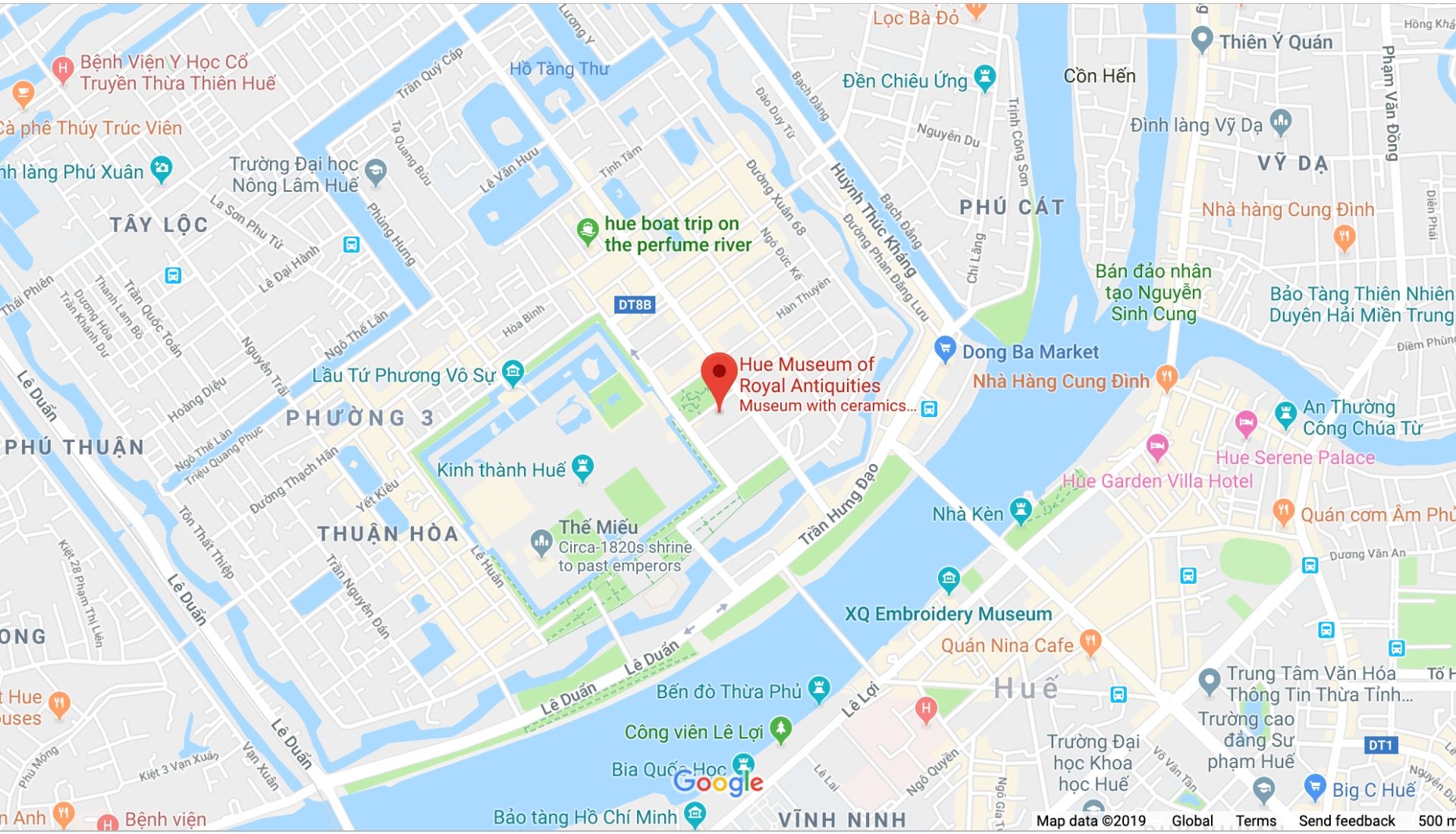
The Museum of Antiquities contains bronze, Phap Lam enamel, pottery, court robes, the bed of Emperor Khai Dinh and more. The impressive building contains 35 poems and essays on wooden panels written by Emperor Thieu Tri.
Essential Information for Visiting Hue Vietnam
How To Book Your Imperial City Hue Walking Tour
Promo Code: totraveltoo2023 to book your tour and get 5% offHow To Get To Hue Vietnam
Danang is the closest airport to Hue for international visitors. Hue does have a domestic airport located 16km from town.
Flight Tickets To Danang
Find the cheapest flights with Skyscanner our ‘go-to’ when researching and booking flights throughout the world.
Air Asia, the budget carrier, has flights to Hanoi, Ho Chi Minh City, Danang and Nha Trang, from major Asian cities.
What to wear to the Imperial City Hue
You do not have to cover up when visiting the Imperial City. We would recommend:
- comfortable walking shoes
- hat
- plenty of water
- sunscreen
Best Time To Visit Hue Vietnam
January to April is the best time to visit Hue.
Read our article here on the Best Time To Visit Vietnam – all seasons explained to help plan your visit to Vietnam.
Where To Stay In Hue
We stayed at the Hue Garden Villa Hotel located in the centre of Hue. The hotel is situated a few minutes walk from the Weekend Walking Street of Hue down a quiet alleyway. There is a swimming pool available. The hotel serves a good breakfast and the WiFi is good.
Latest Guest Review: A fabulous place to stay. We particularly loved room 201 with its private balcony over the pool. The staff were wonderful and we shall definitely return to swim in the pool and just relax in general. Our favourite place to stay so far.
We can also recommend the Emm Hotel. The Emm Hotel is located a little further out from the centre of Hue. It also has a swimming pool and a rooftop terrace with great views.
Guest review: Good location, value for money & especially the hospitality from the staffs 
Do You Need a Visa for Vietnam
Most countries require a visa to enter Vietnam. Check below if you do need one. Our partner ivisa can also organise for your photos online to accompany your visa application.
Travel Insurance
We recommend taking out travel insurance when you book and pay for your flights and pay deposits on tours and cruises.
Are you on Pinterest? We are at To Travel Too and we have many travel-related boards check us out at Pinterest. If you enjoyed our article why not pin it to your board.
To Travel Too Travel Shop
We have partnered with Amazon to bring you over 350+ travel-related products. Click here to go shopping.
We hope you have enjoyed our review of one of the most popular Hue City Tours.
In conclusion, the Imperial City Walking Tour in Hue offers a fascinating and immersive experience of Vietnam’s rich history and cultural heritage. From its majestic architecture to its captivating stories, visitors are transported back in time as they explore the grandeur of the imperial capital. With knowledgeable guides who provide insightful commentary and an itinerary that encompasses all the major highlights, this tour is a must-do for anyone visiting Hue. Whether you are a history enthusiast or simply curious about Vietnamese culture, the Imperial City Walking Tour guarantees an unforgettable journey through one of Vietnam’s most iconic landmarks.



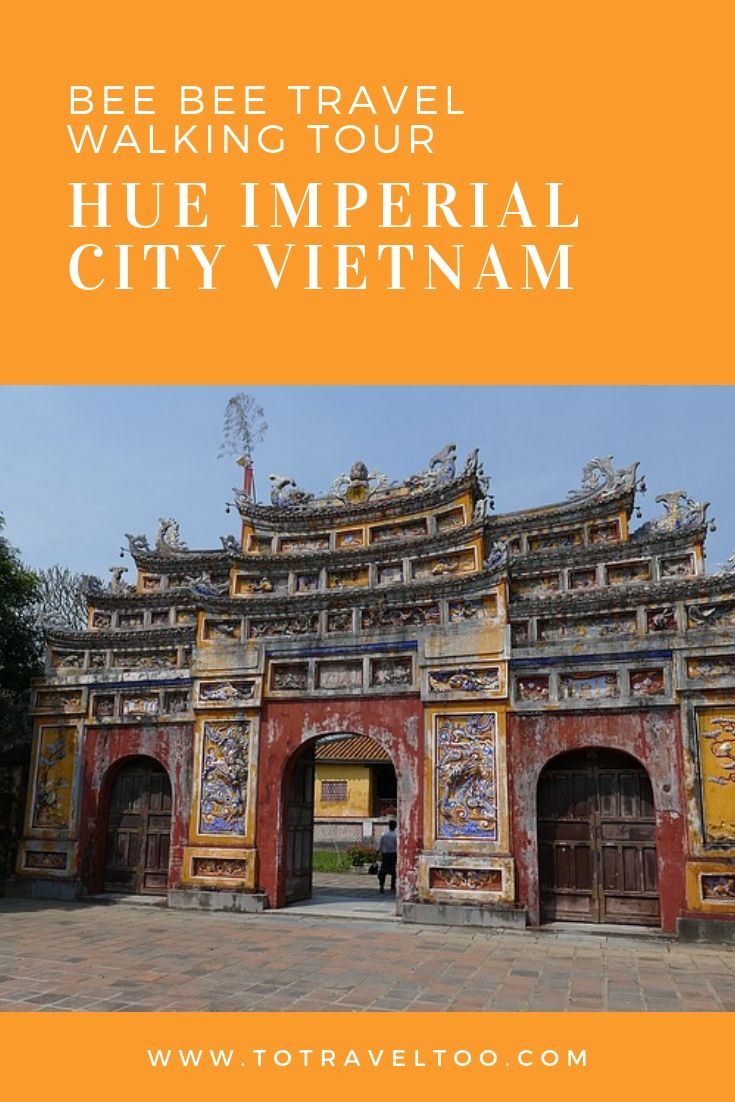
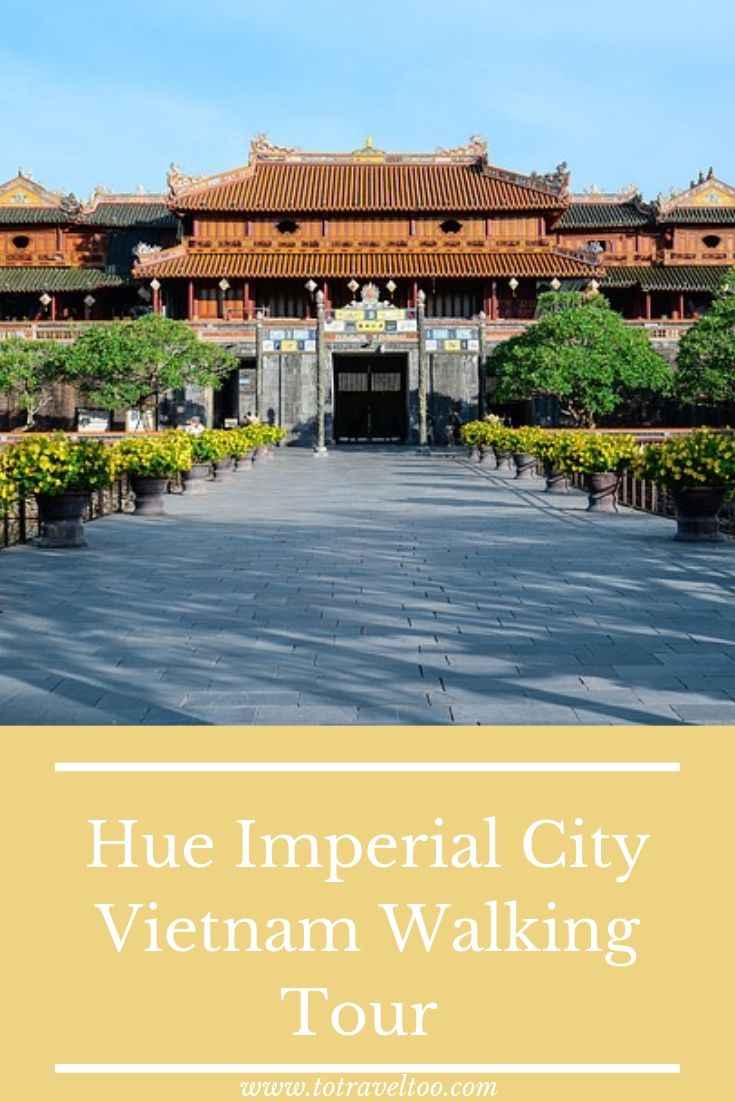
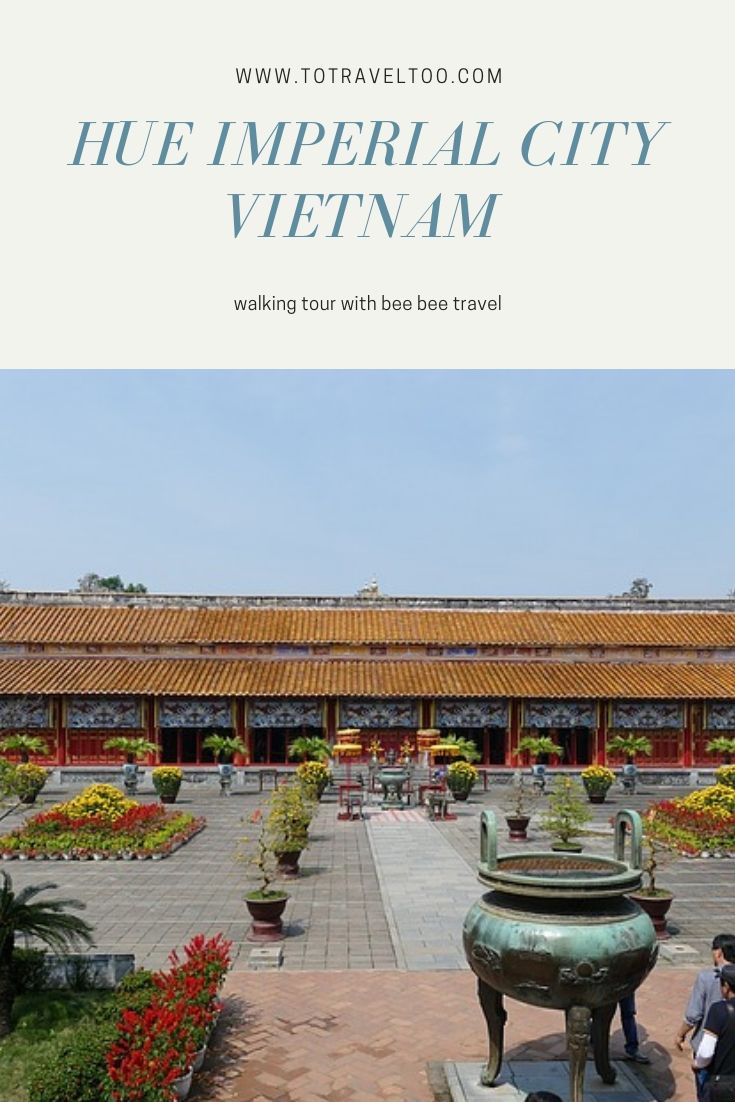




What a fantastic resource for visiting Hue. I recently booked our first trip to Vietnam for February and our itinerary has us in Hue for a couple of nights, mainly so we can visit the Imperial City. I’m really grateful for all the advice plus historical background and will check out the tour company you’ve recommended as well. Thanks again!
Hi Kavita
Thanks for your comments. We have some more articles coming up in the next few weeks of other tours we have done with Bee Bee Travel as well.
Hope you enjoy Hue as much as we did.
Cheers Jane and Duncan
The Imperial City of Hue is just incredible. I don’t know where to start with all the places you mentioned on the tour. Given the country’s tragic past, it’s motivating to see many of the buildings actually still in tact! It’s been a while since I was last in Vietnam, I’d like to see it for myself if I return one day.
Hi Lisa
Thanks for your comments. It is truly an interesting destination.
Cheers Jane and Duncan
This a fantastic comprehensive guide to visiting the Imperial City of Hue. I’d love to visit Hanoi and Ho Chi Minh City so this seems like a great stop off point. There’s so much history attached to this place so I agree that a guided tour must be the best way to see everything.
Hi Laura
Thanks for your comments. Vietnam is an amazing country and hopefully when you visit you can plan at least a few days in Hue.
Cheers Jane and Duncan
I have not been to Vietnam before but I love walking tours and would be keen to try this one. Also I like visiting UNESCO sites so The Imperial City must go on my list. Thanks for all the historical background and the amazing photography it really helps put everything in perspective and I can imagine myself there.
Hi Joella
Thanks for your comments. Hope you can add Hue to your travel wish list.
Cheers Jane and Duncan
It looks like an underrated place. Is it for a day trip or for several days? I haven’t heard of this place but it looks attractive. This country has many places which are not known by travelers.
Hi Mijia
Thanks for your comments. We stayed for 7 nights as there is so much to do and see there.
Cheers Jane and Duncan
A very intriguing tour. Loved the details you have shared. My fav was the purple forbidden city and the Hall of Supreme Harmony. Both had an interesting tale to shad. Wish I get to it some day
Hi Ami
Thanks for your comments. Hopefully you can visit one day and enjoy the Imperial City tour.
Cheers Jane and Duncan
I so agree with you on hiring a local city guide to take you around. I learnt it a hard way after aimlessly moving around sites with rich history. Hue seems like a great city and I am glad you hired a guide to show you around.
Hi
Thanks for your comments. Hue is indeed a great city and we hope that you can visit one day and enjoy a tour with a guide.
Cheers Jane and Duncan
As a gamer it’s so cool to learn about those 9 holy cannons and how 5 of them are assigned elements, like you often see in video games. If only they could actually shoot fire, water, etc. like they probably would if they were in a game, eh? 😉
Hi Vanessa
Thanks for your comments.
Cheers Jane and Duncan
You are a great writer. I just saved your site.